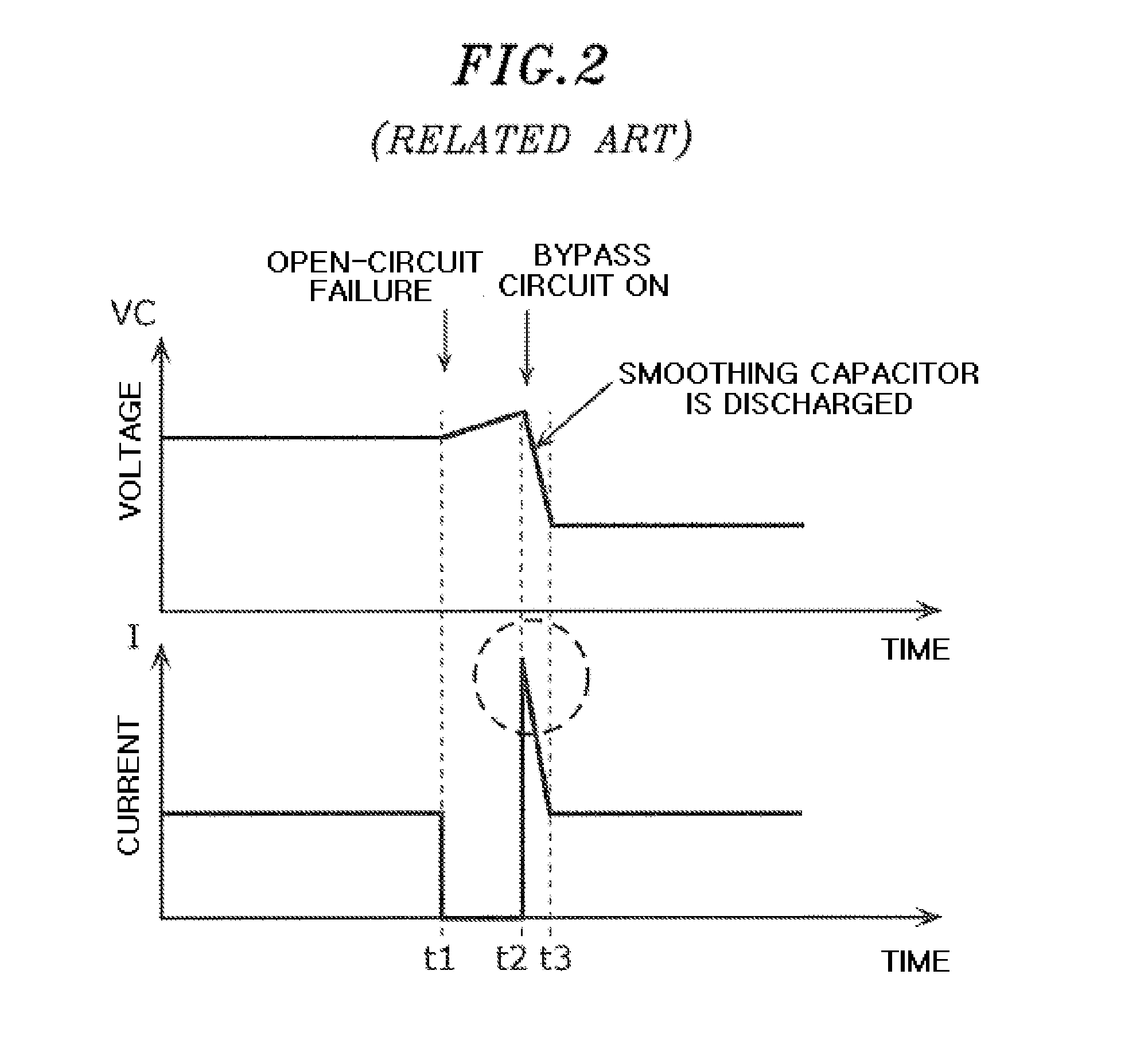Lighting device and luminaire
a technology of light-emitting devices and luminaires, which is applied in the direction of lighting devices, electrical devices, light sources, etc., can solve the problems of excessive current flowing in the other normal, deteriorating or failing normal leds, and affecting the normal operation of normal light-emitting elements, so as to prevent the normal light-emitting elements from deteriorating or failing, and suppress excessive current.
- Summary
- Abstract
- Description
- Claims
- Application Information
AI Technical Summary
Benefits of technology
Problems solved by technology
Method used
Image
Examples
first embodiment
[0081]According to the first embodiment, when an open-circuit failure has occurred, a luminaire releases electric charges accumulated in a smoothing capacitor and then turns on a bypass circuit. Specifically, the luminaire releases electric charges accumulated in the smoothing capacitor by interrupting a constant-current circuit for a predetermined time period after the open-circuit failure has occurred. By doing so, it is possible to suppress excessive current flowing in normal light-emitting elements when the bypass circuit is turned on.
[0082]FIG. 3 is a circuit diagram of a lighting device 210a according to the first embodiment of the present invention.
[0083]The lighting device 210a lights solid-state light-emitting elements connected in series to each other, e.g., LEDs 202a and 202b, by using power from a commercial power source 201. The lighting device 210a includes a DC power source 211, a constant-current circuit 212, a smoothing capacitor 213, a detection circuits 214a and 2...
second embodiment
[0126]The second embodiment to be described below is a modification of the first embodiment. In addition to the elements of the first embodiment, the lighting device 210b according to the second embodiment further includes a discharge circuit for discharging electric charges in the smoothing capacitor 213 during the discharge period.
[0127]In the following description, descriptions will be made focusing on differences between the first and second embodiments, and redundant descriptions on the same elements will be omitted.
[0128]FIG. 7 is a circuit diagram of a lighting device 210b according to the second embodiment of the present invention. In addition to the elements shown in FIG. 3, the lighting device 210b shown in FIG. 7 further includes a discharge circuit 220. The bypass control unit 216b includes the functionality of the bypass control unit 216a.
[0129]The discharge circuit 220 is connected in parallel to the smoothing capacitor 213 and includes a switching element connected i...
third embodiment
[0138]In the above embodiments, the discharge period terminates when the voltage VC becomes lower than the predetermined voltage Vf_min. According to the third embodiment, the discharge period terminates after a predetermined time period has elapsed from the start of the discharge period.
[0139]FIG. 12 is a circuit diagram of a lighting device 210d according to the third embodiment of the present invention. The configuration of the lighting device 210d shown in FIG. 12 is identical to that of FIG. 7 except that the configuration of a bypass control unit 216d is different from that of the bypass control unit 216b. As in the configuration shown in FIG. 7, the configuration in which the discharge circuit 220 is employed and the constant-current circuit 212 stops during the discharge period will be described as an example in this embodiment. However, the discharge circuit 220 may not be employed or the constant-current circuit 212 may not stop during the discharge period.
[0140]The bypass...
PUM
 Login to View More
Login to View More Abstract
Description
Claims
Application Information
 Login to View More
Login to View More - R&D
- Intellectual Property
- Life Sciences
- Materials
- Tech Scout
- Unparalleled Data Quality
- Higher Quality Content
- 60% Fewer Hallucinations
Browse by: Latest US Patents, China's latest patents, Technical Efficacy Thesaurus, Application Domain, Technology Topic, Popular Technical Reports.
© 2025 PatSnap. All rights reserved.Legal|Privacy policy|Modern Slavery Act Transparency Statement|Sitemap|About US| Contact US: help@patsnap.com



